The Huawei P8 Review
by Andrei Frumusanu on June 4, 2015 8:00 AM EST- Posted in
- Smartphones
- Huawei
- Mobile
- P8
- Kirin 930
Battery Life
The P8 has an typical 2680mAh (10.19Wh) enclosed battery which serves as the power source of the phone. This puts the expected lifetime of the P8 towards the lower range of today's smartphones, but given the rather efficient screen, it could go either way for the Huawei flagship.
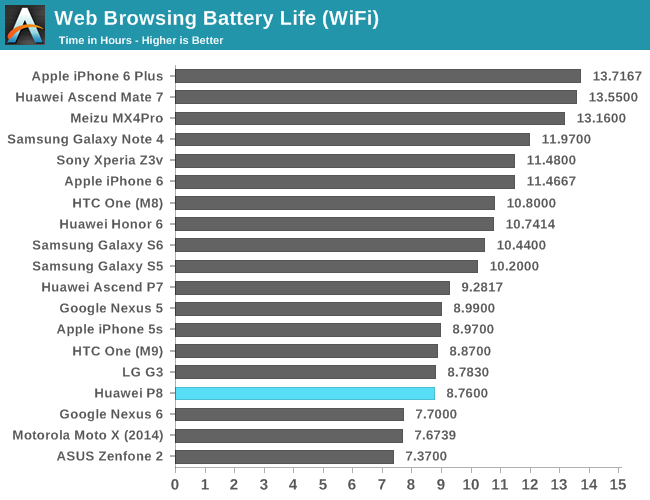
Starting off with our WiFi web-browsing test, we see the P8 achieve 8.76h of lifetime. Although, again, we have to mention that this doesn't particularly represent any groundbreaking number, it still is a good performance given the battery size of the phone.
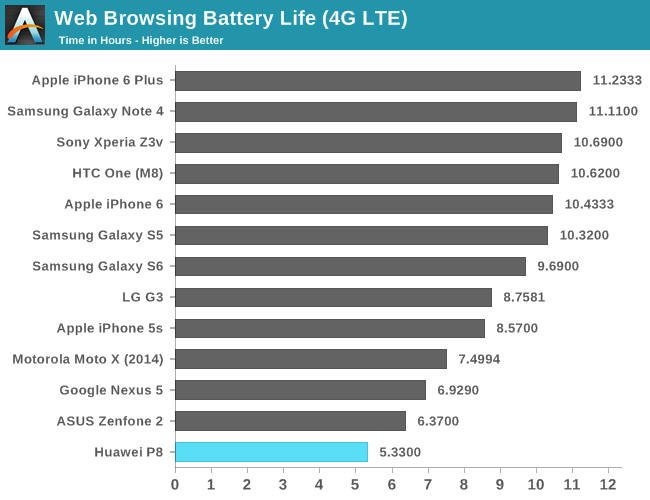
I've tried a go on LTE testing for the P8. In previous reviews I've mentioned that I had patchy coverage for 4G, but the P8 still managed to get an average reception. I'm not sure which frequency band it used, but I suspect it must have been the 1800MHz or 2100MHz band as the 800MHz band on my location is too weak and caps out at 0.2Mbps. As a reminder, this poses a discrepancy in the results as our other editors are able to test battery life under better signal conditions.
The HiSilicon Balong modem sadly performed very badly, coming in at only 5.33h. The device was getting noticeably warm when compared to the WiFi test - meaning the modem and RF system are at fault.
We now move on to PCMark battery test, which is a mixed load benchmark with web browsing, video playback, word processing and photo editing.
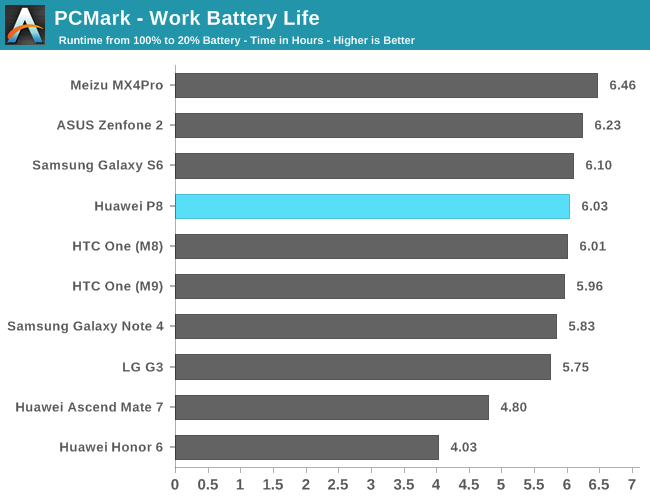
The P8 scored 6.03h, which is good and on par with other devices. This test in particular showed some horrid results for the Kirin 920 devices and showed off how inefficient that SoC could be during normal loads. One remark I would like to make is that the P8's battery life may be actually a tad higher as reported by PCMark because the test artificially stops when the battery gauge reaches 20%; I've noticed in other tests that the fuel-gauge in the P8 can be rather inaccurate, as the actual battery was able to still provide current for another half hour in our web tests even when showing 1% capacity. The same is valid on the other end, as the device will show 100% even though it will continue charging for another half hour after that.
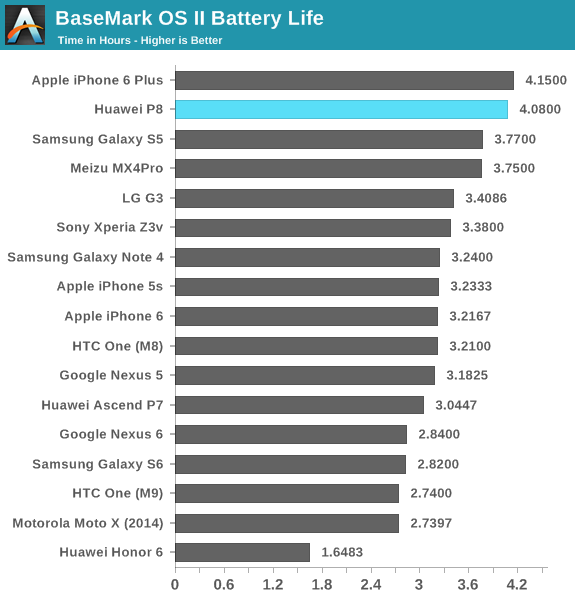
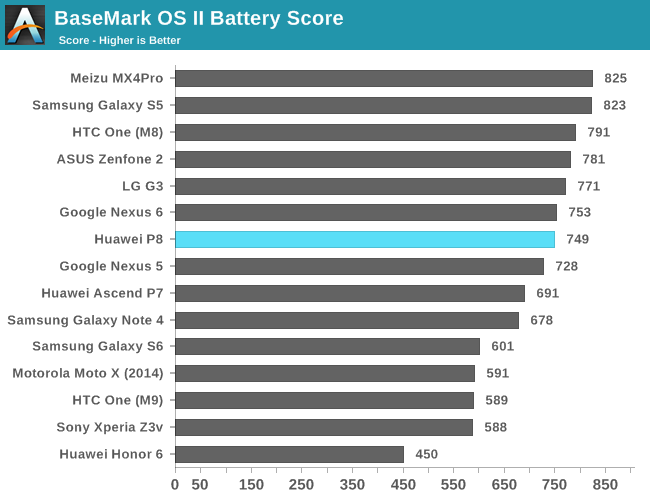
In BaseMark OS II's battery rundown test which stresses mainly the CPU with high loads, the P8 manages to score very well. This is an expected outcome as the Kirin 930 has no large CPU cores which could cause high power drain and lower the efficiency of the phone.
While I didn't have the proper tools to root the P8 to be able to get detailed power curves on the CPU cores, I again relied on the internal fuel-gauge to get some estimates through a CPU power virus.
| Huawei P8 Device Power & Kirin 930 CPU Load Power (Estimate as measured by internal fuel-gauge) |
||||||
| Avg. Total Power | Incremental Difference |
|||||
| Idle | ~0.91 W | - | ||||
| 1 Thread | ~2.48 W | ~1571mW | ||||
| 2 Threads | ~3.03 W | ~556mW | ||||
| 3 Threads | ~3.56 W | ~533mW | ||||
| 4 Threads | ~4.19 W | ~624mW | ||||
Idle power is measured at 200cd/cm² and comes in at around 0.91W. Looking at the incremental differences in power when adding additional threads seems to add somewhere in the region of 570mW. This is a reasonable number for a Cortex A53 core clocked at 2.0GHz on a 28nm process.
What is shocking though is the 1W overhead that happens when going from idle to 1 thread load. Theoretically what should be included in this figure is the power consumed by the performance cluster other non-CPU blocks coming out of their power-gated states. I haven't seen this behaviour happen on other SoCs such as from Samsung or MediaTek, where this overhead was usually only around 20% of a single core's power. This phenomenon is a tad worrisome as the impact on the Kirin 930's power efficiency could be quite large. This is definitely an aspect that warrants more investigation once I have the proper software tools for the P8.

On GFXBench, the P8 managed to perform well at 3.8h runtime, but only because the SoC throttles to ~45% of its maximum performance for about the whole duration of the run.
One notable metric that we don't really have a objective test-case for is idle battery life. Having now several devices in my collection I tend to leave them on on WiFi for extended periods without using them. The P8 was surprisingly bad in this metric as it only ever managed to survive for 2 to 3 days, while for example my Samsung devices are able to go up to 7-10 days under the same conditions and installed applications. I don't remember having quite as bad idle lifetime on the Honor 6 or the Mate 7, so I hope this is a software issue as opposed to increased power consumption by miscellaneous device components.
Charging Time
Althrough Huawei promised that the P8 would include a quick-charger by default during their London launch event, the actual device just had a normal 5W charger bundled in. In fact, the bundled accessories look nothing like the ones that were presented during the launch:
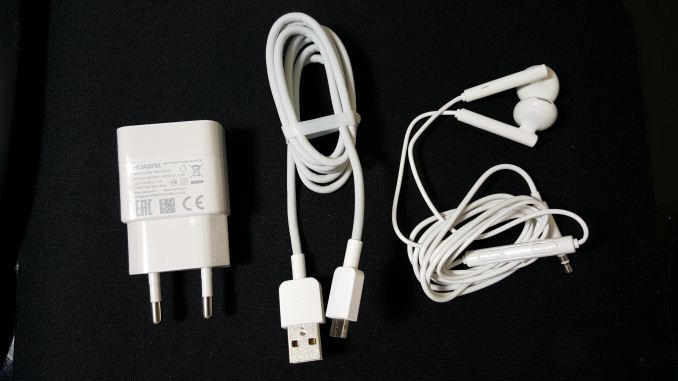
5.0V 1A charger... generic USB cable, similar but definitely not the same premium headphones ..
.. did we miss part of the story here?
Huawei offers also offers the device in more premium variants with a higher clocked 2.2 GHz SoC and 64GB of NAND memory, so there's the possibility that maybe the accessories for those versions differ too?
Nevertheless, I tried charging the phone with various other chargers with higher power outputs and voltages, but the P8 remained an exceptionally slow charger no matter what I connected it to.
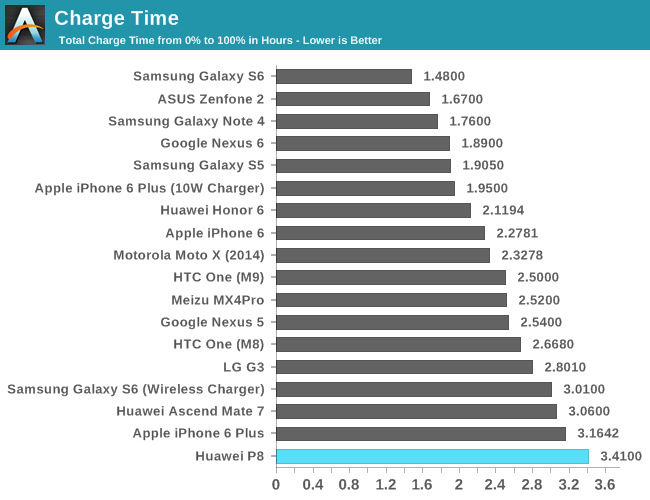
The end results is that the P8 is one of the slowest charging smartphones we've yet tested. While it's understandable that Huawei might have backed off the fast-charging claim in order to preserve the battery longevity of the P8, but having it charge even slower than Mate 7's 4100mAh battery is quite a feat in itself. A device teardown by IT168 revealed that the battery chemistry comes in at only 3.8V versus 3.85V such as in the Mate 7 and other modern devices, pointing out that Huawei chose to employ cheaper materials. Again we see the a quite misleading battery percentage gauge, as even though the P8 hits 100% after 175 minutes of charging, the battery still receives current for another 30 minutes until it is truly fully charged.
If you're low on battery and want to charge your device quickly, the P8 is definitely not the device for you, as it takes about an hour to charge only 40% of the battery.


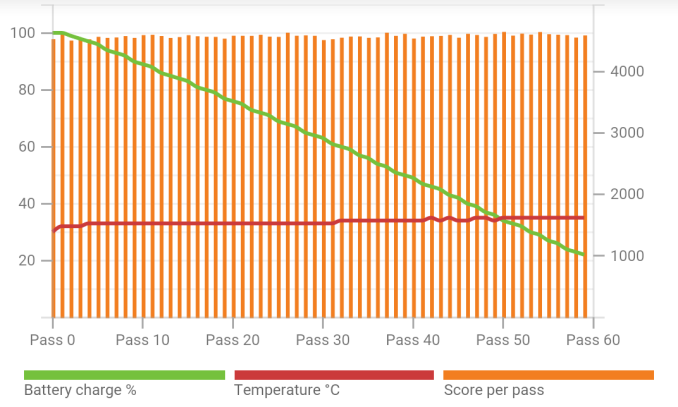

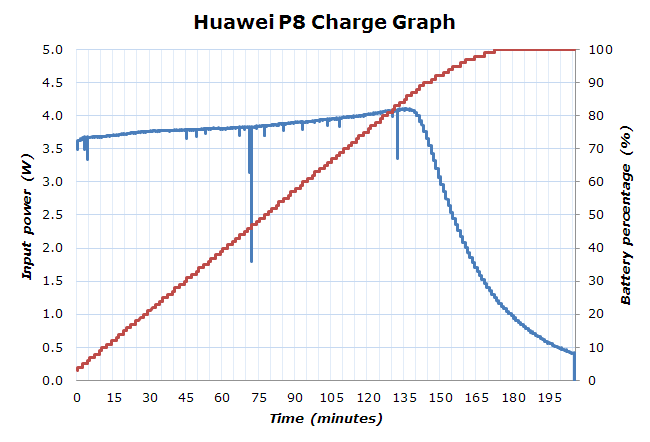








104 Comments
View All Comments
Frenetic Pony - Thursday, June 4, 2015 - link
Yah, the night shots look great. Unfortunately at the cost of the day shots looking not so great, but that's to be expected when trading off color information for luminance information.paffinity - Thursday, June 4, 2015 - link
Free tracking malware by Chinese government? But I guess this is a feature on all phones.pityko - Thursday, June 4, 2015 - link
All you need to do is put a custom ROM over that terrible EmotionUI and you're sorted. I think this is a brilliant handset, you get more for your money than the ridiculously overpriced S6 family.Brakken - Friday, June 5, 2015 - link
'All you need...'? Sounds too much like hard work. Don't have a CompSci degree.Ethos Evoss - Friday, June 12, 2015 - link
you are stupid little brat kiddo little-sht has no idea .. gtfo play your brainwashing stupid gamez useless human being ..bigboxes - Thursday, June 4, 2015 - link
The more competition the better.Peichen - Thursday, June 4, 2015 - link
Can the external and product shots any more Apple like? Take away the Huawei logo and most people would think you are selling iPhones.niva - Thursday, June 4, 2015 - link
Yeah, and what happens when you put an iPhone next to it without it's logo, would you not be able to tell the difference?mkozakewich - Thursday, June 4, 2015 - link
Looks more like an Xperia.Rod_Serling_Lives - Friday, June 5, 2015 - link
This does not look Apple-like even in the shots. I see a much squarer phone with various design highlights. The all metal design with plastic strips to prevent a faraday cage are common place in the world since they are a successful form factor, but each company has done a nice job differentiating themselves. The device looks excellent IMO, it just doesn't perform up to its looks.